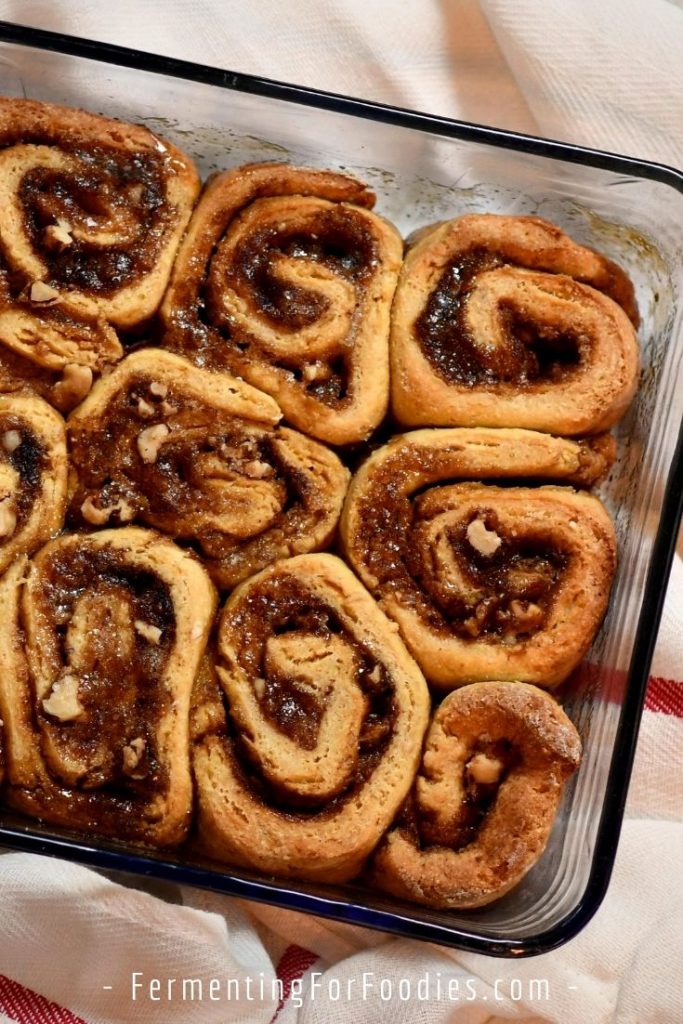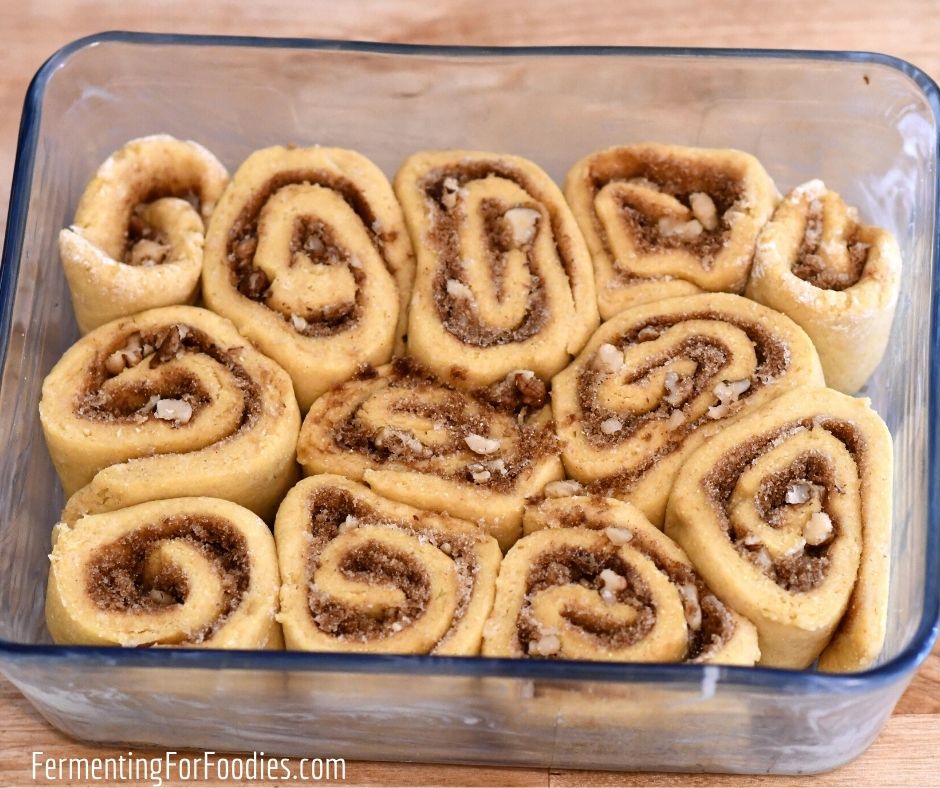Gluten-free cinnamon rolls are rich, chewy, and delicious. They have everything you could want in a cinnamon roll, except the gluten!

Why use sourdough?
It is hard to make delicious, rich-tasting, chewy, gluten-free bread products. Starches, rice flour, and xantham gum just don’t taste that good. Wholegrain gluten-free flours are flavorful and nutty but result in dense baking.
Sourdough fermentation solves all of these problems:
- by breaking down the complex proteins and carbohydrates in wholegrain flours
- adding flavor to baked goods
- using the rising action of yeast, coupled with the acidity of the ferment, to get a double rise
So next time you make gluten-free cinnamon buns, use a sourdough starter!


A low sugar option
We actually don’t really eat a lot of sugar in our house. It’s something we started when my kids were young, so they don’t even enjoy overly sweet flavors.
While I wrote and tested this recipe as a traditional sugared cinnamon bun, I actually make a sugar-free version on a more regular basis. It’s a healthy and delicious option for breakfast or school snacks.
Cinnamon Date Spread
My favorite refined sugar-free filling is a cinnamon date spread. Here’s how to make this high-in-fiber cinnamon bun filling:
- The cinnamon bun dough still needs sugar to feed the yeast. If you want a less sweet dough, reduce the sugar to 1 Tbsp.
- Make a date paste using 1/2 lb. of dates. Halve and pit the dates. Place them in a pot with 1/2 cup of water and 1 Tbsp of ground cinnamon. Bring to a boil and simmer for 5 minutes.
- Remove from the heat and add 1/4 cup of butter. Puree the dates into a smooth paste, which can be spread evenly on the rolled-out cinnamon bun dough. It’s a bit goopy so, roll carefully.
- Follow the rest of the recipe directions as written and enjoy your low sugar cinnamon bun!
Gluten Free Sourdough Cinnamon Rolls
Using a gluten-free sourdough starter helps to make a rich, chewy, and delicious gluten-free cinnamon bun. These buns are perfect for breakfast, brunch, or snacks. See the section above if you want to make these cinnamon buns even healthier by replacing the brown sugar with a cinnamon date filling.
- Prep Time: 2 hours
- Cook Time: 40 minutes
- Total Time: 2 hours 40 minutes
- Yield: 12 1x
- Category: Dessert
- Method: Sourdough
- Cuisine: American
- Diet: Gluten Free
Ingredients
Dough:
- 1 cup sourdough starter
- 1 tsp instant bread yeast
- 3 cups gluten-free flour (+ 1/2 cup for rolling)
- 3 large egg
- 1/4 cup sugar
- 6 Tbsp unsalted butter, melted
- 2 tsp of xanthan gum
- 3/4 tsp salt
Cinnamon Sugar Filling:
- 3/4 cup packed light brown sugar
- 1 Tbsp ground cinnamon
- 2 Tbsp melted butter
- 1/2 cup chopped walnuts (optional)
Instructions
- Stir the instant yeast into the starter. Using instant yeast helps to boost the rising action of the wild yeast.
- Melt 1/2 cup of butter. Then measure 6 Tbsp into the dough (the rest will be brushed on after it’s rolled out).
- Combine all of the rest of the dough ingredients with the starter. Mix thoroughly. The dough should be firm enough that you can knead in the last bit of flour. Let the dough rest for five minutes to hydrate. Then knead it a few times to bring it into a smooth ball. If it is still sticky add a bit of extra flour. (The exact amount will depend on the hydration of your flour. I use GF oat flour for this recipe).
- Gently roll the dough into an 18″ by 12″ rectangle on a piece of parchment paper. Use flour as required, to help with the rolling.
- Brush the rest of the melted butter over the rectangle, then sprinkle on the cinnamon and sugar. Sprinkle on chopped walnuts if you are using them.
- Roll the dough along the 18″ side, into a tight cylinder and squeeze gently to even out the layers.
- Slice into 12 rolls using a sharp knife, and place them in a greased 8 x 8-inch glass dish with the cut side down. Cover with an air-tight lid or a damp tea towel, and let the buns rise at room temperature for 2-4 hours or in the fridge for up to 24 hours.
- Bake at 350 F for 30-40 min (until browning.) Turn upside down immediately upon removing from the oven so the yummy cinnamon sugar drizzles throughout the cinnamon buns.
- Serve immediately, or store in an air-tight container after they’ve cooled. GF cinnamon rolls will last for up to 4 days on the counter, but I recommend freezing them to maintain freshness.
Notes
- The stickiness of the dough will really depend on your flour mix. I like baking with 100% wholegrain flours because they have the best flavor. However, you can use any store-bought gluten-free flour blend
. Just omit the xantham gum if your flour mix already contains a binder.
- Here’s my recipe for a gluten-free sourdough starter. It takes 3-5 days to get a good starter with rice or oat, so plan ahead! Alternatively, buckwheat and teff will both make a strong starter in around 24 hours.
Nutrition
- Serving Size: 1 cinnamon roll
- Calories: 275
- Sugar: 13.1g
- Sodium: 208mg
- Fat: 10.7g
- Carbohydrates: 39.8g
- Fiber: 4.2g
- Protein: 6.4g





Can I freeze them prior to baking?
I usually bake, then freeze my gf baking (because I like to simply microwave then eat 🙂 ) However, I think that should work. Sourdough is supposed to survive freezing. Let me know how it goes!
Yeah this doesn’t seem quite right, I followed the recipie…the fermented overnight was very dry being 1:1 and the dough was very crumbly and it didn’t really rise at all in the oven, normally a cinnamon roll dough is much wetter so I am wondering if the amounts are off or if I should have added water or something, the taste was great but it really was just a crumbly mess
Interesting. I’ve made this a number of times without any issues. Most of the liquid comes from the melted butter in the dough.
Same as me Jeannette! Just a crumbly mess 🙁
Sorry to hear that! I have made this recipe a number of times over the course of 6 years since I first wrote it and never had an issue. Maybe you’re using a flour that needs slightly more water? (White rice flour for example). In that case, keep adding more water until you get a smooth dough. Cheers, Emillie
Absolutely delicious! I’m cooking and baking my way through a number of your recipes and have loved all of them so far. Thanks for making it so easy :o)
Thanks! Let me know if you ever find anything that needs fixing. I try to test my recipes regularly, but haven’t managed to do them all.
Interesting.. . I’ve tested the recipe twice in the past few months, without an issue (once using a rice flour blend, once with a buckwheat flour blend). I think part of the issue is that melted butter is actually part of the liquid. It is not for the filling, but the dough. The eggs plus 6 tbsp of melted butter is a total of just under 1 cup added liquid, in addition to the sourdough starter. Altogether it is enough to make a dough stiff enough to roll out.
Just to check (for the next time I test this recipe, likely sometime soon!) How much extra liquid did you have to add?
I added an extra 1/2 cup of water but it still seemed dry, also why didnt you use Gram measurements, as well as how thick should the dough be when you roll it out, etc?
Hi, I live in North America and don’t typically cook by weight. Sorry, I don’t know how to accurately convert this recipe for you (beyond using an internet converter). If you roll it to an 18″ x 12″ rectangle then it will be quite thin, around 1/4″ thick. As for the liquid, I think it’s because different gf flours have different absorption rates. I generally like to allow readers to use their favourite flours, but perhaps I will start to convert all my recipes to my favourite flours to prevent issues like this.
Cheers, Emillie
The kids loved these buns. I made some cream cheese frosting, was a nice treat.
It would be super helpful to know the blend of gf flours you use as this can really impact a recipe— for instance, if you make your own blend of gf whole grain flours, what are they and what percentage of each? Thank you!
Hi Erin, You’re right… I always like to let people use their favourite flours, but it does require a bit of paying attention as not all flours absorb the same amount of liquid.
I’ve made these buns with just buckwheat flour, just oat flour and with my GF baking flour mix. All three worked well, though I really liked the straight whole grain flours best as the starches, etc. in a mix really didn’t add much to the flavour or texture. If you want to try my flour mix here is the recipe: https://www.fermentingforfoodies.com/gluten-free-baking-flour-mix/
Enjoy!
looking through google for a sourdough gf cinnamon roll. I’ve used this page before and it’s been great but disappointed to see yeast in the ingredients. It’s not sourdough if its got yeast in it. its just not the same
If adding yeast to boost the sourdough isn’t something you want to do, then it’s fine to leave it out. Just ferment for a longer period (8 to 24 hours). I like to add a boost to help the rise for most of my GF sourdough recipes. It’s just an insurance policy against really dense GF bread. 😉 But in this particular recipe it’s not necessary. Cheers!
Good evening,
I let them proof for about 4 hours and they got kind of a hard crust. I cooked them anyway. They came out crusty not crispy or squishy.
Anything I can do to soften them up a bit?
Did I do something wrong in the recipe?
Thanks!
Sorry to hear that your dough ended up drying out during the proofing. Perhaps try covering it with a damp tea towel next time? You can also add a frosting or glaze which may soften the exterior now. (I will edit to make sure it includes that detail now.) Cheers! Emillie